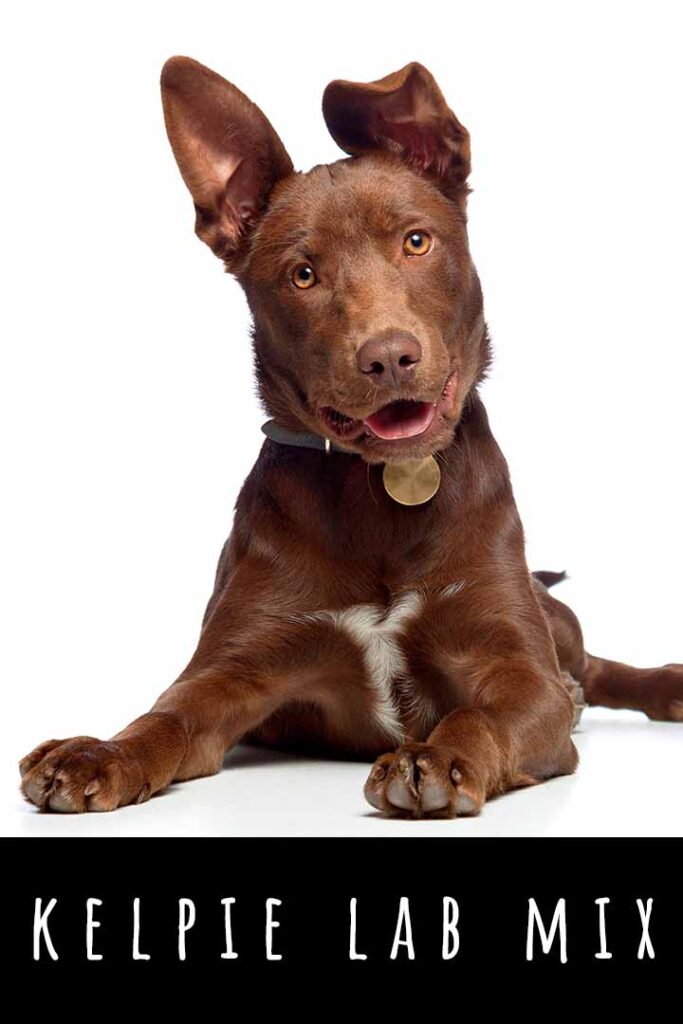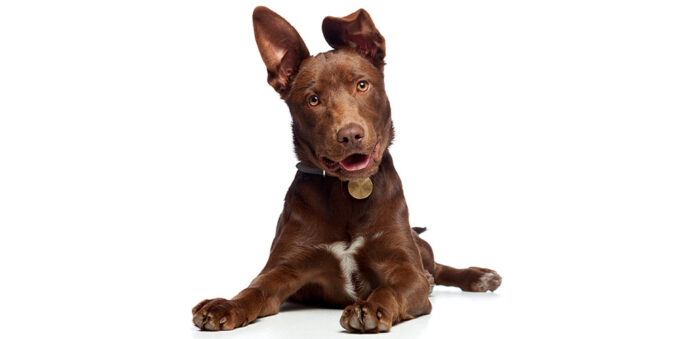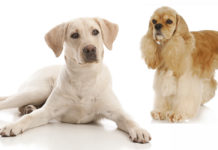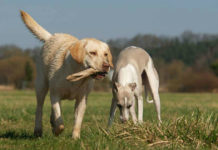A Kelpie Lab mix won’t suit every home. But, if you’re looking for an energetic, intelligent companion, a Lab x Kelpie could be right for you!
- Kelpie Lab mix temperament
- Australian Kelpie Lab mix appearance
- Health and care needs
- Puppy guide: how to find a breeder
A Kelpie Lab mix combines the protective, energetic Australian Kelpie with the friendly, affectionate Labrador Retriever. The resulting mix can vary, but generally puppies grow to be medium dogs with plenty of drive and intelligence! These dogs do best in active homes, and need daily mental stimulation to prevent destructive behaviors.
What is a Kelpie Lab Mix?
Breeding two purebred dogs together to create a mixed breed has become a popular trend over the past decade. And, the Labrador is a favorite for this process, thanks to their loving, family-oriented temperament. The Kelpie Lab mix is a mixed breed that results from breeding a Labrador Retriever with an Australian Kelpie.
However, like all mixed breeds, the outcome of a Kelpie x Labrador can be unpredictable. There’s no way of knowing exactly what traits puppies will inherit from each parent until they’re born. So, it’s important that owners are prepared for any potential outcome. And this means getting to know both parent breeds very well!
Kelpie and Lab Mix Temperament
The Labrador’s temperament is a big part of its popularity for mixed breeds. When well socialized, Labs are friendly, affectionate, and loving. They’re clever dogs that have plenty of energy. And, since they’re also often very eager to please, they take to training very well. This temperament is partly due to generations of breeding for such a personality, but also to a history of working alongside humans in retrieving roles.
The Australian Kelpie is equally energetic and intelligent. In fact, this breed is known for their ability to learn and their limitless energy. Throughout their history, Kelpies have worked as sheep-herding dogs in Australia, and many can be found in this role today. They form strong bonds with their owners, but can be reserved around strangers and other dogs when not well socialized. And, they may display herding behaviors towards young children and other pets.
Importance of Socialization
Socialization is an important process for all dogs. If you socialize your dog well before they reach 12 weeks of age, they will feel happier and more confident in new situations as an adult dog. Socialize your puppy to anything they might experience as an adult, like a busy school yard, people in wheelchairs, trains, busy roads, and more. Keep all experiences positive. Pairing new and potentially scary things with treats and affection is a great way to help your puppy get used to them from a distance. Over time, you can move closer.
Socialization won’t eliminate any natural instincts – for instance, the instinct to herd. But, it can help to minimise the risk of fear-related aggression. So, be aware of the potential natural instincts in this mix before committing to one.
Australian Kelpie Lab Mix Appearance
The Australian Kelpie and Labrador Retriever breeds share some key traits. For instance, they are both well-built, muscular dogs that suit a working lifestyle. They both also have a dense, double layered coat that sheds moderately. Though both have triangular ears, the Kelpie’s tend to stand erect, whilst the Lab’s flop over. Both have relatively long, straight tails and a healthy muzzle that will keep them cool as they work or exercise.
The Labrador comes in three colors – black, chocolate, and yellow. But the Kelpie has a wider range, including black and tan, blue, fawn, red, and red and tan. Some of these shades are dominant over others. But, modern breeders can work to increase the likelihood or certain colors. So, whether you’re searching for an Australian Kelpie black Labrador mix, an Australian Kelpie chocolate Labrador mix, or one of the more unusual Kelpie colors, you’re likely to find what you’re looking for.

How Big Are Kelpie Lab Mix Dogs?
Size is another trait that can vary from one Kelpidor to the next. Adult Labradors are large dogs. Fully grown, they will stand between 21.5 and 24.5 inches tall, weighing anywhere from 55 to 80 lbs. Some may fall outside of this boundary, but these measurements are the most common. And, females tend to be smaller than males.
Australian Kelpies, in contrast, are smaller. When fully grown, they usually stand between 17 and 20 inches tall, weighing between 35 and 50 lbs. Like Labs, females are often smaller than males.
The exact size of your Kelpie Lab mix will depend on which parent it favors. Some puppies will grow to be at the upper limit of the Labrador range, but others might be as small as the smallest Kelpie. And, some might fall entirely in between, being the perfect middle ground. Adult size is not something that’s easy to predict. The best way to get an idea of potential size is to examine the parent dogs.
Kelpie Lab Mix Training and Exercise
The Australian Kelpie Lab mix is blessed with two intelligent and energetic parents. Both dogs have a working history, and so a mix between them will be equally clever and active. Training is vital for this mix. Not only to instil good behaviors, but also to provide some mental stimulation and burn off some of that limitless energy. Multiple training sessions each day are a great idea, as is investing in some interactive toys.
Positive reward training will work well for this mix. It will build on the strong bond you have with your dog, but also plays up to the Lab parent’s love of food. Just make sure you subtract your training treat allowance from your dog’s daily calories, to keep them at a healthy weight.
This mix will have a lot of energy. So, they are best suited to large homes with lots of safely enclosed outdoor space for them to roam in. They need energetic families that can dedicate at least an hour every day to exercise. This can include hiking, retrieving, agility, swimming, and more. If they do not get enough exercise, a Kelpie Lab mix can become bored and unhappy, which can lead to destructive and unwanted behaviors like barking, digging, chewing, and more.
Kelpie Lab Mix Health
Although mixed breed dogs live, on average, longer than purebred dogs, they can still be prone to the same hereditary health issues as their parents. For example, the Labrador is particularly prone to joint issues, so a Lab mix puppy may experience the same problems. Here are some of the most common problems that can impact a Kelpie x Labrador.
- Hip and elbow dysplasia
- Arthritis
- Exercise induced collapse
- Gastric dilatation volvulus
- Atopic dermatitis
- Progressive Retinal Atrophy
- Heart problems
- Centronuclear Myopathy
- Intestinal Lipid Malabsorption
Health testing can reduce the likelihood of these problems. So, make sure you’re choosing a reputable breeder who prioritises the health of their puppies over all else.
Are Australian Kelpie Lab Mixes Good Family Dogs?
In the right home, a Kelpie Labrador can make a great family dog. But, they won’t suit all homes. This is an intelligent mix that has lots of energy. So, they’ll need a lot of exercise every day, as well as mental stimulation. Training can offer some exercise and mental stimulation, but this mix will need more than training alone. They won’t suit apartment life, or sedentary families.
Though Labrador Kelpie mixes tend to be friendly and affectionate, especially towards family members, they can have natural herding instincts. This means they might try to herd children and other pets in your household. Which can obviously be quite stressful for the children and pets involved! So, it’s worth bearing this in mind before committing to a Kelpidor puppy.
Training is a must for this mix. If you do not have the time to dedicate to training, you should consider a different dog. The Kelpie parent is very clever, especially at problem solving. So, this mix need a confident, experienced owner who can channel that intelligence into productive, rather than destructive, behaviors. A Kelpie Lab mix can also be quite a vocal dog, if it favors its Kelpie parent.
Finding Kelpie Lab Mix Puppies
The Australian Kelpie is not a popular breed in America. So, you may struggle to find a Kelpie Lab mix in the states. The easiest place to find this mix is in Australia, but it is possible to get one elsewhere in the world. And, because this mix is not common or popular, there is a smaller chance of puppy mills and backyard breeders taking advantage of customers.
In your search for a breeder, be prepared to have to sit on a waiting list for litters. Ask plenty of questions, and make sure you see evidence of health testing. The best breeders will want their puppies to go to good homes that are well suited to this mix’s high energy. So, they will ask you plenty of questions in return.
There’s a chance that you will find this mix in rescue centers. Particularly as some owners might have to give them up if they underestimate just how much exercise and mental stimulation the mix needs. Rescue center dogs will be cheaper, but you won’t be able to control your dog’s early experiences and socialization. So, they may not suit homes with other pets or with young children. Work with rescue center staff for more help and information on individual dogs.
Similar Breeds
The Kelpie Lab mix won’t suit all homes. But, they have some wonderful traits. Here are some other breeds and mixes with similar traits that you might also want to consider.
- Border Collie Lab Mix
- Pitbull Lab Mix
- Black Lab Australian Shepherd Mix
- Black Mouth Cur Lab Mix
- Lab Setter Mix
Australian Kelpie Lab Mix – A Summary
This mix is an energetic and clever breed that will be happiest when it has a job to do. It may have strong herding and hunting instincts, so won’t suit all homes! But, in the right family, this active dog can make a wonderful sidekick.
Do you have a Kelpie Lab mix? Let us know what they’re like in the comments!
Readers Also Liked
- Dog Exercise: How To Exercise Your Labrador And Keep Them Fit
- Dog Recall – Get A Great Recall With Our Training Tips And Guides
- How Much Exercise Does My Labrador Need?
References and Resources
- Lofgren, S. (et al), ‘Management and Personality in Labrador Retriever Dogs’, Applied Animal Behavior Science (2014)
- Howell, T. (et al), ‘Puppy Parties and Beyond: The Role of Early Age Socialization Practices on Adult Dog Behavior’, Veterinary Medicine: Research and Reports (2015)
- Cutler, J. (et al), ‘Puppy Socialization Practices of a Sample of Dog Owners from Across Canada and the United States’, Journal of the American Veterinary Medical Association (2017)
- Hiby, E. (et al), ‘Dog Training Methods: Their Use, Effectiveness and Interaction with Behavior and Welfare’, Animal Welfare (2004)
- Deldalle, S. & Gaunet, F. ‘Effects of 2 Training Methods on Stress-Related Behaviors of the Dog (Canis Familiaris) and on the Dog-Owner Relationship’, Journal of Veterinary Behavior (2014)
- Donner, J. (et al), ‘Frequency and Distribution of 152 Genetic Disease Variants in Over 100,000 Mixed Breed and Purebred Dogs’, Plos Genetics (2018)
- Urfer, S. (et al), ‘Risk Factors Associated with Lifespan in Pet Dogs Evaluated in Primary Care Veterinary Hospitals’, Journal of the American Animal Hospital Association (2019)
- Graham, M. (et al), ‘Lesion Distribution in Cases of Canine Atopic Dermatitis in South Australia’, Australian Veterinary Journal (2019)
- O’Brien, M. (et al), ‘A Large Deletion on CFA28 Omitting ACSL5 Gene is Associated with Intestinal Lipid Malabsorption in the Australian Kelpie Dog Breed’, Scientific Reports (2020)
The Labrador Site Founder
Pippa Mattinson is the best selling author of The Happy Puppy Handbook, the Labrador Handbook, Choosing The Perfect Puppy, and Total Recall.
She is also the founder of the Gundog Trust and the Dogsnet Online Training Program
Pippa's online training courses were launched in 2019 and you can find the latest course dates on the Dogsnet website


















